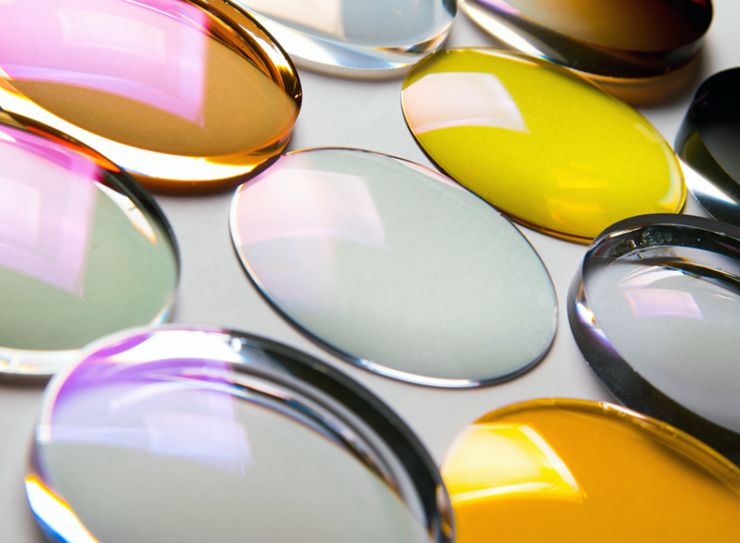
Optical Glass
Optical Glass describes a broad range of glass material meeting specific optical requirements and is generally one of two types, Flint Glass (produced using lead) or Crown Glass (produced using higher levels of potassium oxide). The primary optical characteristics determining the light path through the glass include Refraction (Refractive Index) and Dispersion (Abbe Number). Optical Glass is designed in its chemical composition to selectively transmit or block light of different wavelengths.
Generally produced in a bulk format, Optical Glass is procured as a block, ingot, pressing or plate. Coresix maintains the process capabilities to transform the material of your choice to the exact format and physical specifications needed for your application.
Optical glass is commonly used in components for photography, microscopy, spectroscopy, chemical analysis, machine vision and a wide range of optical instrumentation. For applications requiring precision control of light transmission, Coresix sources optical glass from the leading manufacturers including Schott, CDGM, Ohara and Hoya.
PROCESS

Substrate
Though we can achieve almost any format from standard sheet glass, custom components often require specialty glass materials like Fused Silica, BK7, and other Optical Glass. These materials can take the form of Blocks, Pressings, Cores, or Plates and require additional steps to create a suitable substrate for further processing. At Coresix, we have the tools and experience to convert any format of raw material into a finished component of your specifications.
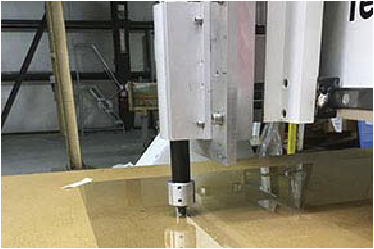
Cutting
For standard sheet glass materials, Coresix has a range of Precision Mechanical Scribe tables to meet most size requirements. Bulk materials are converted to appropriate blanks and, if necessary, can be further cut using the scribe process or Water Jet for intricate shapes. Often, processing (including lapping, polishing, optical coating, etc.) is more cost-effectively performed on a larger part, which can then be cut and formed to the final dimensions.
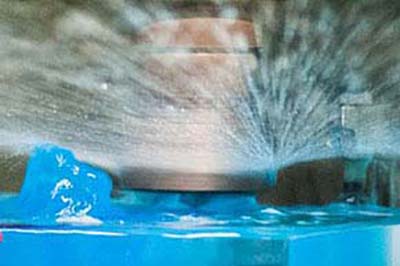
Edging
Though CNC Edging is available within certain size limits, a more cost-effective approach for small parts is to Hand Seam edges and corners on a diamond grinding wheel. This is a very consistent process that eliminated the sharp edge and corners making the parts safe to handle and promoting cleanliness through reduced particle migration.

Lapping
Custom components will often require custom thickness or other characteristics (flatness, parallelism, etc) not available in standard material formats. Coresix maintains a variety of Single-Side Lapping and Double-Side Lapping processes with sufficient capacity to produce parts to your unique specifications in any quantities.
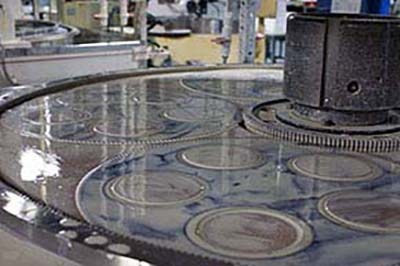
Polishing
Once lapped to thickness (and other requirements), whether as a substrate or in finished format, the surface and subsurface damage must be removed to bring the glass back to a clear state. We have an array of Double-Side Polishing processes to create surfaces from optically clear to ultra-low defects. We also offer Super Polish to achieve a smooth surface as low as 2A RMS.
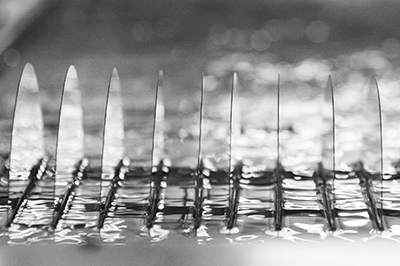
Cleaning
Our in-house tooling department can create custom carriers to enable Ultrasonic Cleaning of nearly any format parts up to 500mm square. We have multiple cleaning lines feeding directly into a Class 100 Optical Clean Room, where parts can be inspected under the most stringent conditions and packed to maintain cleanliness all the way to your door.
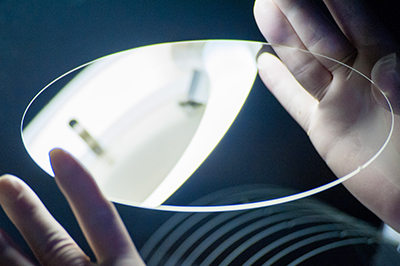
Inspection
Within our Class 100 Optical Clean Room, our most advanced inspection practices can be applied to nearly any part format. While metrology (Thickness, Parallelism, Flatness, Roughness, etc.) is often performed at the substrate level, a variety of lighting conditions are employed to inspect each part visually, assuring surface quality and cleanliness requirements are met 100% of the time.

SPECIFICATION
Dimensional Specifications
Most dimensions are limits under optimal conditions and are subject to evaluation upon inquiry.
| Attribute | Minimum | Maximun | Tolerance |
|---|---|---|---|
| Thickness | 100µm | 200µm | +/- 2µm |
| Thickness Tolerance | n/a | n/a | +/-10% |
| Dimensions (Scribed Edge) | 5.0mm x 5.0mm | 1300mm x 2600 mm | +/- 50µm |
| Diameter (Scribed Edge) | 6.0mm | 1200mm | +/-100µm |
| Diameter (CNC Edge) | 100.0mm | 300.0mm | +/-25µm |
| Corner Radius (Scribed Edge) | 6.0mm | n/a | +/-500µm |
| Corner Radius (CNC Edge) | 2.0mm | n/a | +/-100µm |
| Thickness Variation (TTV) | n/a | <10% | n/a |
| Scratch and Dig | 5/2 | 1.5K Lux (Standard) | n/a |
| Ultrasonic Cleaning | 50mm x 50mm | 350mm x 350mm | n/a |
Actual specifications will be dependent upon material, format, and other factors. We will be glad to evaluate your requirements and advise the best possible process available.
CAPABILITIES

Dimensional
Whether from stock glass sheets or custom-produced substrate, small window and cover glass components are cut to size using a mechanical scribe process. The dimensional tolerances of this process, depending upon the part size and material thickness, can be held to as low as +/-25 microns. If a fully ground edge, custom shape, or other features are needed, CNC edging can be used to hold tolerance and relative positioning to within 25 microns. Hand seaming, the most common and economical method of edging small format glass, will not change the dimensional tolerance of the part. These edges and corner crops can be applied to customer requirements with repeatability within 50 microns.
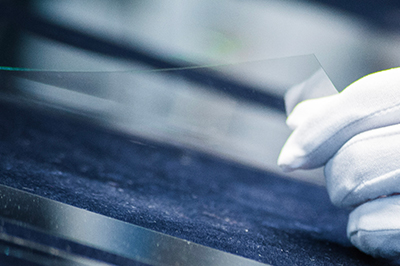
Thickness
If standard sheet glass thickness doesn’t meet your needs, or components are to be made from a bulk glass format, an appropriate substrate can be prepared to tolerances below 5 microns with thickness variation within each part to below 1 micron. We will evaluate your material and thickness requirements to propose the most effective process at the lowest price point.
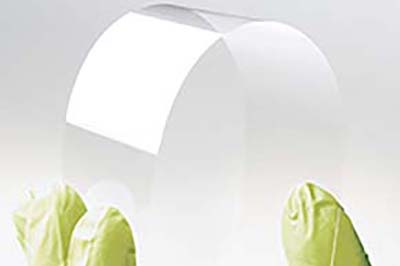
Flexibility
If your intended application for Willow Glass™ involves bending of the substrate, it is essential to understand Compression vs. Tension and orient your part accordingly.
Though Coresix has established and regularly tests our scribe process to maximize edge quality and resulting strength, bending the glass toward the scribe side, thereby “compressing” the micro-fractures created by the scribe, will result in the strongest condition.
Coresix identifies the compression side as part of our standard packaging procedure.
Importance of Orientation
If your intended application for Willow Glass™ involves bending of the substrate, it is essential to understand Compression vs. Tension and orient your part accordingly.
Though Coresix has established and regularly tests our scribe process to maximize edge quality and resulting strength, bending the glass toward the scribe side, thereby “compressing” the micro-fractures created by the scribe, will result in the strongest condition.
Coresix identifies the compres-sion side as part of our stan-dard packaging procedure.
Willow Glass Packaging
Small Format
For sizes up to 500mm Square, parts are “stacked” with Tyvek paper interleaf, shrink-wrapped, and placed in a cardboard box with a protective liner.
Large Format
Sizes exceeding 500mm are “stacked” with Tyvek paper interleaf in a custom-sized wood crate with a protective liner.
Cleanliness Critical
For applications requiring minimization of particulate, parts are packed using additional plastic sheet liner to reduce in-transit contamination.
Bendable Glass
Though it may seem impossible, bendable glass is possible and it is used in a variety of applications in the rapidly growing world of technology. Corning willow glass can be found in a variety of markets, such as mobile consumer electronics, display, and more emerging markets as the technology grows.
Contact us today if you need our bendable Willow Glass from Corning for your products.
For more information about Willow Glass, click on one of the below links to download the pdf.